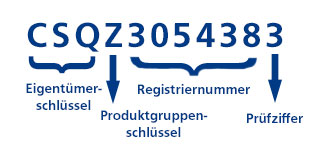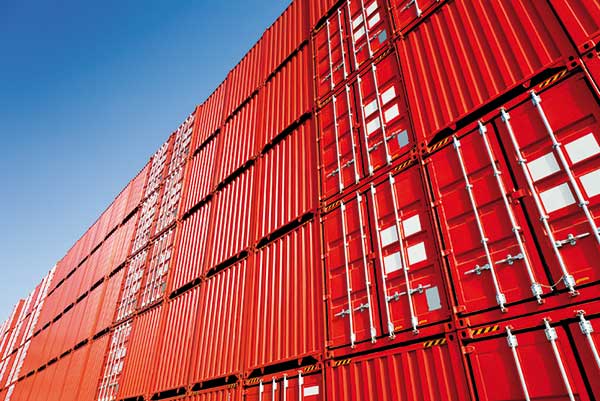In our information sheet Container Knowledge we clarify the most important questions for the coding of containers:
- How is a container number composed?
- How do I calculate a check number?
- What are the encodings for container sizes?
Answers to these questions can be found here.
Container number according to ISO 6346
To create a container marker according to the international standard ISO 6346:
Structure of the container number

Each container receives a globally unique container number, which is clearly visible on both fronts. It consists of the three-digit owner key (letters A-Z), the product group key (U,J,Z,R) of a six-digit serial number and a check digit calculated from all 10 characters and digits. The latter is used to exclude incorrect input by number turners.
Applying for the owner key for container identification
Each owner key is unique. This is ensured by registering with the International Bureau of Containers (BIC – Bureau International des Container – 14, Rue Jean Rey, 75015 Paris). Registration can be done directly with the BIC or can be carried out through a national organisation. The GERMAN representation of the BIC is the SGKV Studiengesellschaft für s/o in Frankfurt (www.sgkv.de).
Product group key in container label
The product group key consists of one of the three uppercase letters:
- U – for all containers
- J – for equipment that can be attached to the container
- Z – for trailers and chassis
The combination of owner key plus product group key is also known as “alpha prefix” or “owner code”.
The serial number in the container label

The registration number is unique and consists of six digits. If the container number consists of fewer than six digits, so many zeros are preceded until a six-digit sequence of numbers is obtained.
Calculating the check digit for container identification
The check digit is used to check the correct transmission of the owner code and registration number. This control is carried out automatically by data processing systems such as freight information systems (FIS) or transport information systems (TIS) and refuses to accept the container number if there is no compliance with the check digit.
The check digit according to ISO 6346
This is how the check procedure of the standardized container label works.
Test method for container number validation
The process is defined in such a way that multiple delivery errors cannot be overturned. This excludes the assumption of incorrect data. The test procedure works as follows:
Calculate check number: Step 1
Each letter of the alphabet is assigned an equivalent numerical value, which begins with 10 at the letter A and is counted further, with omission of the 11 and their multiples.
The digits of owner code and registration key are converted to these values.
| a | B | c | D | E | Q | g | H | Ⅰ | J | K | l | M |
| 10 | 12 | 13 | 14 | 15 | 16 | 17 | 18 | 19 | 20 | 21 | 23 | 24 |
| n | O | P | Q | R | s | t | U | V | W | X | Y | z |
| 25 | 26 | 27 | 28 | 29 | 30 | 31 | 32 | 34 | 35 | 36 | 37 | 38 |
Check number calculate step 2
The data processing system multiplies each digit according to its position by numerical values from 2 x 2 to 2 x 9 – see table below.
| Digit | 1 | 2 | 3 | 4 | 5 | 6 | 7 | 8 | 9 | 10 |
| Exponent | 0 | 1 | 2 | 3 | 4 | 5 | 6 | 7 | 8 | 9 |
| Multiplikator | 1 | 2 | 4 | 8 | 16 | 32 | 64 | 128 | 256 | 512 |
Check number calculate step 3
- Add all the results from step 2
- Divide them by 11
- Round all decimals to full numbers
- Multiply the full numbers by 11
- Subtract the result (4) from the addition result (1): This rest is the check digit!
If the rest is 10, the check digit is 0. Since check digit 0 can be duplicated, the standard recommends that you do not use registration numbers that result in the rest of 10.
If the check number is entered correctly, the system accepts the data – otherwise it would claim the entry.
Size and type codes for cargo containers
Overview of the size and type keys valid according to ISO 6346
Digit Length
| Code | Länge mm | Länge ft |
|---|---|---|
| 1 | 2991 | 10 |
| 2 | 6058 | 20 (TEU) |
| 3 | 9125 | 30 |
| 4 | 12192 | 40 (FEU) |
| B | 7315 | 24 |
| c | 7430 | 24,6 |
| g | 12500 | 41 |
| H | 13106 | 43 |
| l | 13716 | 45 (HC) |
| M | 14630 | 48 |
| n | 14935 | 49 |
Digit Height
| Width in mm | Height | |||
| 2,438 (8ft) | -2500 | over 2500 | Mm | Ft |
| 0 | 2.438 | 8 | ||
| 2 | c | l | 2591 | 8.6 |
| 4 | D | M | 2743 | 9 |
| 5 | E | n | 2895 | 9.6 |
| 6 | Q | P | >2895 | >9.6 |
| 8 | 1295 | 4.3 | ||
| 9 | Mind. 1219 | at least 4 |
ISO Type Codes
| ISO Code | Description |
|---|---|
| G0 | General – Openings at one or both ends |
| G1 | General – Passive vents at upper part of cargo space |
| G2 | General – Openings at one or both ends + full openings on one or both sides |
| G3 | General – Openings at one or both ends + partial openings on one or both sides |
| V0 | Fantainer – Non-mechanical, vents at lower and upper parts of cargo space |
| V2 | Fantainer – Mechanical ventilation system located internally |
| V4 | Fantainer – Mechanical ventilation system located externally |
| R0 | Integral Reefer – Mechanically refrigerated |
| R1 | Integral Reefer – Mechanically refrigerated and heated |
| R2 | Integral Reefer – Self-powered mechanically refrigerated |
| R3 | Integral Reefer – Self-powered mechanically refrigerated and heated |
| H0 | Refrigerated or heated or with removable equipment located externally; heat transfer coefficient K=0.4W/M2. K |
| H1 | Refrigerated or heated with removable equipment located internally |
| H2 | Refrigerated or heated or with removable equipment located externally; heat transfer coefficient K=0.7W/M2. K |
| H5 | Insulated – Heat transfer coefficient K=0.4W/M2. K |
| H6 | Insulated – Heat transfer coefficient K=0.7W/M2. K |
| U0 | Open Top – Openings at one or both ends |
| U1 | Open Top – Idem + removable top members in end frames |
| U2 | Open Top – Openings at one or both ends + openings at one or both sides |
| U3 | Open Top – Idem + removable top members in end frames |
| U4 | Open Top – Openings at one or both ends + partial on one and full at other side |
| U5 | Open Top – Complete, fixed side and end walls ( no doors ) |
| T0 | Tank – Non dangerous liquids, minimum pressure 0.45 bar |
| T1 | Tank – Non dangerous liquids, minimum pressure 1.50 bar |
| T2 | Tank – Non dangerous liquids, minimum pressure 2.65 bar |
| T3 | Tank – Dangerous liquids, minimum pressure 1.50 bar |
| T4 | Tank – Dangerous liquids, minimum pressure 2.65 bar |
| T5 | Tank – Dangerous liquids, minimum pressure 4.00 bar |
| T6 | Tank – Dangerous liquids, minimum pressure 6.00 bar |
| T7 | Tank – Gas, minimum pressure 9.10 bar |
| T8 | Tank – Gas, minimum pressure 22.00 bar |
| T9 | Tank – Gas, minimum pressure to be decided |
| B0 | Bulk – Closed |
| B1 | Bulk – Airtight |
| B3 | Bulk – Horizontal discharge, test pressure 1.50 bar |
| B4 | Bulk – Horizontal discharge, test pressure 2.65 bar |
| B5 | Bulk – Tipping discharge, test pressure 1.50 bar |
| B6 | Bulk – Tipping discharge, test pressure 2.65 bar |
| P0 | Flat or Bolter – Plain platform |
| P1 | Flat or Bolter – Two complete and fixed ends |
| P2 | Flat or Bolter – Fixed posts, either free-standing or with removable top member |
| P3 | Flat or Bolter – Folding complete end structure |
| P4 | Flat or Bolter – Folding posts, either free-standing or with removable top member |
| P5 | Flat or Bolter – Open top, open ends (skeletal) |
| S0 | Livestock carrier |
| S1 | Automobile carrier |
| S2 | Live fish carrier |

Download Container Knowledge (PDF)
Download our container knowledge as a PDF:


